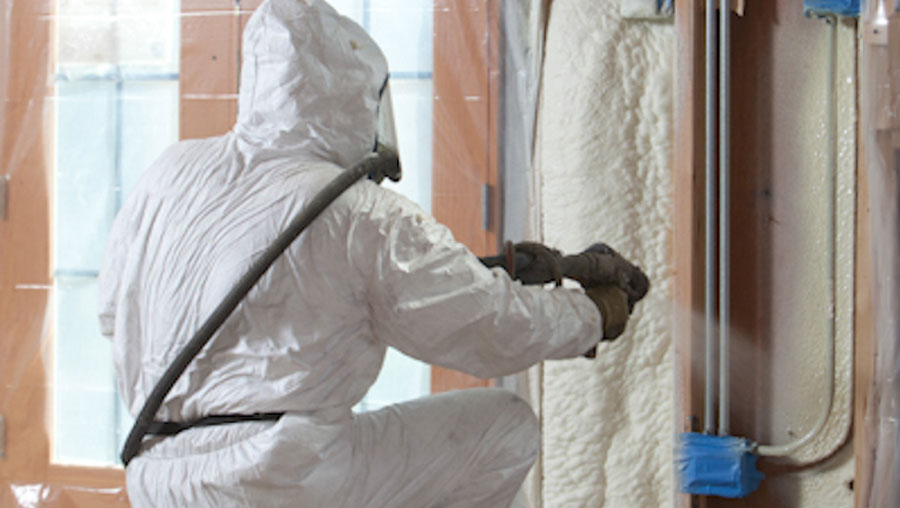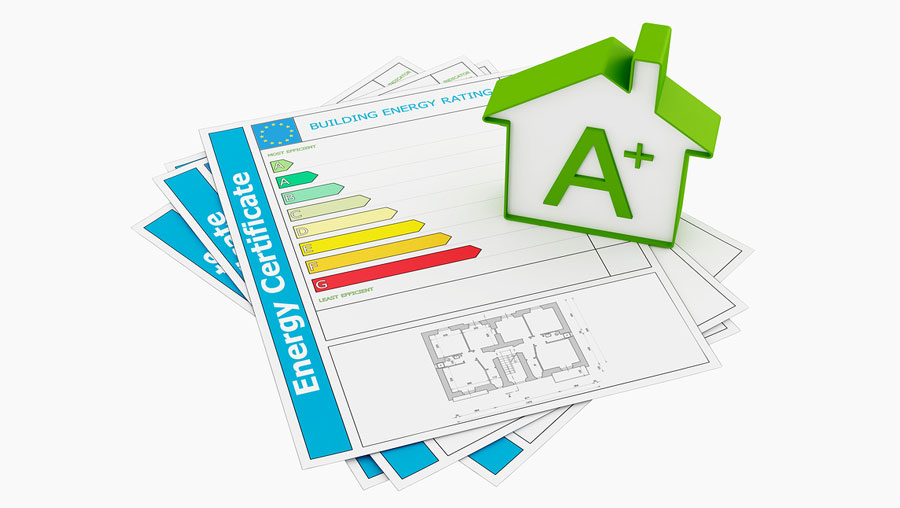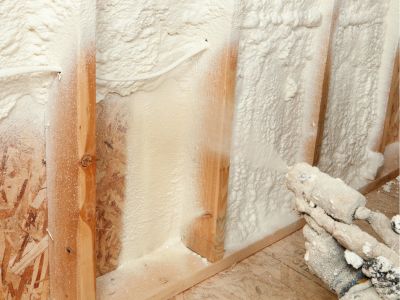 The foam in spray foam insulation is polyurethane. The polymer foam is a combination of isocyanate and polyol resin. The two chemicals react when they come into contact, forming a foam-like substance that expands and then hardens. The foam-like substance is one of the best home insulation materials for various reasons. Here, we'll look at spray foam and what makes it efficient as an insulation. How Does Spray Foam Insulation Work? The white trucks you see carrying spray foam usually store the two chemical components separately. Only when spraying do they come into contact via the nozzle and react to form polyurethane. This semi-liquid foam seeps into nooks and crannies before expanding and hardening to seal off the space completely. Spray foam also contains other additives that give it its characteristic properties. It has blowing agents that create the foam you see. It also has surfactants that help the foam expand to maximum and reduce the amount used. Lastly, it has fire retardants, making it fire-resistant and safe for home installation in Orlando. Types of Spray Foam Spray foam is available in two different types, each having unique properties. They include:
Benefits of Spray Foam Insulation Polyurethane spray foam offers numerous benefits. For example:
Get Started Today With a Free Quote At All Florida Insulation, we provide spray-foam insulation services to help improve your home's efficiency and comfort levels. If you live in the greater Florida area, contact us today for a free quote and consultation. We are privileged to serve Orlando, Windermere, Winter Park, Lake Nona, Longwood, and Winter Garden, as well as the nearby communities. Click to see all our services.
0 Comments
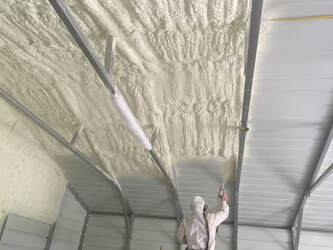 An estimated 10% of homes in Orlando have spray foam insulation. The percentage keeps growing each year as more homeowners realize its benefits. If you want spray foam insulation installed, you are ahead of most homeowners. But what is spray foam insulation, and is the driver behind this increased adoption? Keep reading to find out. What is Spray Foam Insulation? Spray foam is an insulation material that comes in two forms: open-cell and closed-cell. It comes as a liquid chemical that your professional contractor sprays onto walls and ceilings and then cures. It consists of isocyanate and polyol resins that react and expand to create a solid layer that prevents air leakage, heat transfer, and moisture build-up. Spray foam is not entirely a new insulating material. It came to the market in the 1980s and was used for industrial and commercial projects and in cars and airplanes. Much later, it became suitable for residential buildings and has become one of the top insulation materials for Orlando homeowners. But what is the driving force behind this trend? Factors Influencing the Usage of Spray Foam in Orlando 10% of Orlando homes have spray foam insulation because of its benefits. For example: Reduced Energy Bills Homeowners have realized they could drastically reduce their AC bill by installing spray foam insulation. But how does it work? Essentially, it creates an airtight seal and provides the highest R-value per inch. This airtight seal blocks all air drafts and keeps the conditioned air inside your home. It also minimizes thermal bridging, which reduces heat transfer through building materials. As a result, your AC does not have to work twice as hard to maintain comfortable indoor temperatures. The Environmental Protection Agency EPA estimates it can save about 20% of energy costs. (1) Improved Air Quality The airtight seal created by the insulation foam also bars air pollutants such as dust, allergens, and pollen from entering your house. Usually, your house has holes, cracks, and gaps that let the outdoor air in. This air carries pollutants and easily gets trapped in your home and is often the beginning of allergies and respiratory ailments. Spray foam insulation helps improve your home's indoor air quality by completely sealing these spaces. Since it's a liquid before curing, it fills every nook and cranny and then expands and solidifies. Durability You will not have to replace spray foam insulation after a few years of use. It can serve your Orlando home for 80-100 years. Unless you want to remodel your home, you will never have to worry about replacing it. This longevity makes it a cost-effective option compared to other insulation materials. Let Us Help You Benefit From Spray Foam Insulation Spray foam insulation works best if you have an expert installer. Look no further than All Florida Insulation. We have served Orlando for over a decade and earned a reputation for quality work and material. Also, our company services Winter Park, Longwood, Clermont, Ocoee, and the surrounding communities. Contact us today via phone ((407) 410-FOAM (3626)) or email to request an estimate. Click to see all our services. 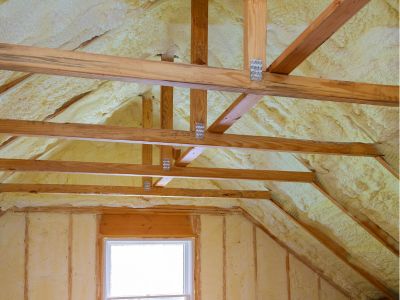 Spray Foam insulation offers superior insulation compared to other materials. It creates an airtight seal, which helps reduce air infiltration and increases your home's energy efficiency. But where do you install it to ensure maximum effectiveness? Here, we'll briefly discuss the best place to install spray foam insulation in the attic. Underside of Roof Deck The ideal location to install spray foam insulation in the attic is on the underside of the roof deck. It should be right below the sheathing, where the rafters meet the roof decking. The space allows for a complete seal that creates a thermal barrier between indoors and outdoors. But why is the underside of the roof deck the best place to install spray foam insulation? Here is why. Airtight Sea Spray foam insulation, especially closed-cell foam, creates an airtight seal. When installed on the underside of the roof deck, it fills all gaps and crevices, leaving no room for air infiltration. That means the cold unconditioned air from outside does not enter your attic, and the warm air from inside does not escape. As a result, your HVAC system does not have to work as hard, leading to energy savings and reduced utility bills. Moisture Control Another advantage of installing spray foam insulation on the underside of the roof deck is its ability to control moisture. The seal created by the foam prevents moisture from entering your attic. The material is water-resistant, meaning it will not become a breeding ground for mold and mildew. Controlled humidity is crucial as it prevents structural damage, improves indoor air quality, and protects your home's insulation. Moisture can also cause thermal bridging, which reduces the effectiveness of your insulation. Spray foam insulation in the attic helps tackle this issue. Professional Installation Spray-foam insulation is an excellent choice for your attic, and installing it on the underside of the roof deck provides numerous benefits. However, you need an experienced professional to install it correctly. At All Florida Insulation, we have a team of experts ready to assist you any day. We are privileged to serve Orlando, Windermere, Winter Park, Longwood, Winter Garden, and Altamonte, as well as the nearby communities. Contact us via phone ((407) 410-3626) or email and request a quote. Click to see all our insulation services. 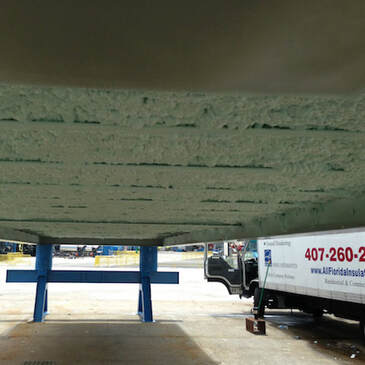 Are you looking for an efficient, cost-effective way to insulate your home or commercial building? If yes, you've most likely researched insulation materials and encountered spray foam insulation (SPF). SPF is among the top sought-after insulating materials for many reasons. But what is spray foam insulation made from? As insulation experts, we'll briefly discuss the composition of SPF here. What is Spray Foam Insulation Made of? Spray foam insulation consists of two main liquid chemicals: isocyanate and polyol resins. The two react and combine to form a polyurethane foam that expands to create a solid layer of insulation. The polyurethane, a polymer, is the main component of SPF. It forms an essential part of insulation and gives the spray foam its desirable properties. For example, it is stable and does not react further after curing, making it a long-lasting insulator. It also performs well against harsh elements such as heavy rains and extreme temperatures. Additionally, polyurethane does not soak water, making it the perfect insulator for preventing microbes. How Is Spray Foam Made? The two chemicals, isocyanate, and polyol resins, come in different storage tanks. They are then pumped through heated hoses and only mix at the spray gun nozzle, where they react. The reaction forms an expanding foam that sticks to surfaces. This polyurethane foam fills cracks, gaps, and spaces and provides a seamless insulation layer. With a professional team, the application process should only take a few hours. Types of Spray Foam Insulation There are two types of SPF: open-cell and closed-cell. Depending on your insulation needs and budget, you can opt for either. Here's a brief description of each type:
Professional Spray Foam Installation At All Florida Insulation, we know everything about spray form insulation, having installed it in thousands of homes across Florida. We can help you choose the right type of SPF and professionally install it for maximum efficiency. We are privileged to serve Orlando, Windermere, Winter Park, Lake Nona, Longwood, and Maitland, as well as the nearby communities. Contact us today via (407) 410-FOAM (3626) to learn more and get an estimate! Click to learn more about us. 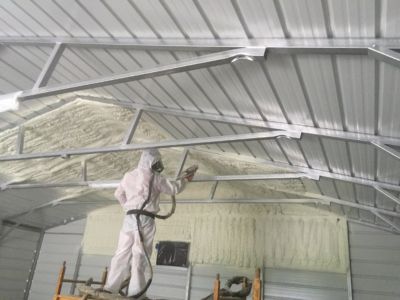 Generally, it only takes 2-3 days to install spray foam insulation (SPF) in most Orlando homes. SPF is an excellent insulation option for Florida's humid climate. But the timeline of installation can vary depending on several factors. Here, we'll explore the factors that affect how long it takes to install SPF in a home located in Orlando. Size of Home How long spray foam installation takes will depend on the size of your home. Naturally, if you have a large space, it will likely take longer than if you have a smaller one. That's because it requires more insulation material and labor, translating into more time. In contrast, smaller homes require less time and often take two days or less. Access to Attic Access to the attic space is another factor that affects how long it takes to install spray foam. For instance, the architecture of some homes in Orlando prevents easy access to the attic space for various reasons. In such cases, installing the SPF may take more than two days. The delay is mainly due to additional time required for scaffolding and cutting holes or other necessary steps. On the other hand, if your spray foam contractor can safely and easily access the attic, installation should be fast and smooth. Type of Spray Foam Finally, the type of spray foam you're installing can also affect how long it takes to complete the task. There are two main types of SPF: Closed-cell foam and Open-cell foam. Both of them have their own merits and demerits. However, open-cell foam is the fastest to install. It is less dense, more flexible, and expands rapidly. That makes installation much quicker and easier. On the other hand, closed-cell foam is thicker and requires a longer installation time. But it offers greater insulation performance and durability. Work With Professional From All Florida Insulation While the above factors matter, the most critical factor in the installation time of spray foam is who you work with. You need highly experienced and specialized professionals to do the job quickly, safely, and effectively. They also need to have high-quality equipment and materials. Fortunately, you can find all that at All Florida Insulation in Orlando. We are a team of experienced professionals with an extensive portfolio of successful projects. We ensure timely installation while still guaranteeing quality. Our company services Orlando, Windermere, Longwood, Winter Garden, Lake Mary, and the surrounding communities. Call us today for a free consultation, and let us protect your indoor comfort. Click to see all our services offered. 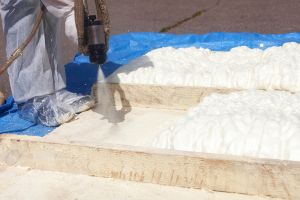 Yes, open-cell spray foam is an ideal insulation solution for Orlando attics. Its thick, air-tight blanket of protection helps keep your home cool and comfortable in Florida's hot climate. But what makes it the perfect attic insulation material? Here we'll briefly discuss the benefits of open-cell spray foam that make it the ideal choice for Orlando homes. Improves Thermal Performance One of the best characteristics of open-cell spray foam is its ability to get into small crevices and cracks. Once applied, it expands and dries completely, blocking out any air leakage. That way, it provides an excellent heat transfer barrier. The heat transfer barrier helps keep your attic cooler, blocking the hot air from entering your home. With cooler indoors, you can reduce your reliance on air conditioning to keep yours indoors at peak comfort. Prevent Moisture Buildup Apart from blocking out hot air, open-cell spray foam also prevents moisture buildup. The attic area is prone to condensation due to extreme temperature variations. If left unchecked, it can accumulate and create an ideal environment that supports the growth of microbes. These microbes then find their way into your living area leading to lower indoor air quality. When you and your loved ones inhale this air, it can cause severe respiratory issues such as exacerbated asthma and allergies. Furthermore, the water may damage your ceiling and walls leading to costly repairs. But with professional open-cell spray foam insulation, you can stop this chain of events. The material is air-tight and keeps your attic dry and safe from moisture. Noise Reduction Outside noise is a nuisance, especially if you're a light sleeper. Much of that noise comes through the lightweight material on the roof. It can be worse during hail storms and other Florida's inclement weather. Open-cell spray foam provides a thick protective layer on your attic. It acts as a sound barrier. With it, you can have a peaceful sleep without disturbance. Reduced Energy Bills Trying to cool a continuously hot indoor space can be a costly affair. That's because your AC will always run constantly to maintain the set temperatures. Obviously, it will consume more power which translates to higher energy bills. In hot places like Orlando, Florida, the bills will quickly run into hundreds of dollars every month. Luckily you can save money by insulating your attic with open-cell spray foam. The material stops heat transfer from the outside to the inside of your home, maintaining a comfortable indoor space. The only challenge to using open-cell spray foam is that it requires professional installation—no shortcuts to that. You need an experienced contractor with the know-how and equipment to install the material properly. Contact Us Today You don't have to keep up with an uncomfortable home. You also don't have to keep paying high energy bills, even if you can afford them. Contact a professional open-cell spray foam installer today for the best solution for your Orlando attic. At All Florida Insulation, we specialize in open-cell spray foam insulation services. We have a team of professionals who know just the right amount of spray foam to install for optimal insulation. Contact us today for a custom solution that meets your needs and budget. We work in Orlando, Winter Garden, Ocoee, Lake Mary, and Gotha, as well as the surrounding areas. Click to see all our services. 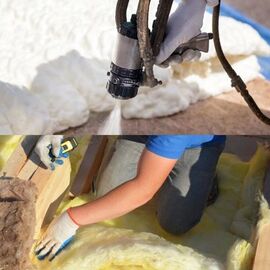 When deciding to insulate your home or business premises, you can easily get overwhelmed by the sheer number of options available. The top two contenders are spray foam and batt insulation. Each has its pros and cons. But which one should you choose? Here, we'll briefly compare spray foam and batt insulation to see which is better. But first. What are Spray Foam and Batt Insulation? Spray-foam insulation is a type of insulation made from a chemical, mainly polyurethane. The chemical solution comes in two types; open-cell and closed-cell. This type of insulation requires specialized equipment and professionals. Batt is an insulation made from fiberglass (glass wool), Rockwool, or polyester. The material comes pre-cut to the exact walls and ceiling fit. Batt works by trapping air via millions of tiny air pockets that slow heat flow. Comparing Spray Foam and Batt: Which Is Better? Thermal Insulation - R-Value When you're out looking for an insulation material, watch out for terms such as R-Value. It indicates the material's effectiveness in resisting heat transfer. The higher, the better. When comparing the two in terms of thermal properties, spray foam insulation wins. That's because it has a higher R-Value per inch (or cm). For example, the closed-cell foam variant has an impressive R-Value of up to 7 per inch, which is among the highest available today. On the other hand, batt insulation provides up to 4.3 per inch in R-Values. This thermal insulation level can be enough for your home, but it drops over time, especially when not professionally installed. Installation Convenience The ease of installation is also a factor when choosing insulation for your home or office. Here, batt insulation comes on top. That's because it's available in standard, pre-cut sizes. That makes it convenient to install in wall studs, ceiling cavities, and attic rafters. If there are irregular-sized spaces, it can allow custom cuts. Basically, batt insulation provides an easy-to-fit solution. On the other hand, installing spray foam insulation is complex. First, it requires highly specialized and expensive equipment. Secondly, it needs professional handling to ensure quality. While the installation process is complex, the final product requires minimal maintenance to non-existent. That's not the case with insulation batts. Moisture/Vapour Barrier Spray foam insulation provides an air-tight barrier against moisture. That's one of the reasons why it is preferable in basement insulation, where moist air is a big problem. However, not all types have this quality. Some open-cell variants do not provide the same degree of moisture barrier as closed-cell foam. Ensure you work with a professional to help choose the right foam insulation type that provides a vapour barrier. On the other hand, insulation batts can not provide a vapour barrier alone. It needs additional backing to achieve this. If you choose this as your preferred method, ensure your contractor knows you need a moisture barrier. Value & Cost Batt insulation is undoubtedly much more affordable than spray foam. The main reason being it's pre-cut and less labor-intensive. However, the price goes up if you wish to include the necessary add-ons. While spray foam is expensive, it's much better. It has more value and last longer. It's also ideal for both commercial and residential properties. At All Florida Insulation, we are your one-stop shop for everything insulation. We have decades of experience working on both residential and commercial insulation projects. Call us at (407) 410-FOAM (3626) to request a free quote. We are privileged to serve Daytona Beach, New Smyrna Beach, and Daytona Beach Shores, as well as the nearby communities. Click to see all our services offered.  The best season to install spray foam insulation depends on your local climate. For instance, if you live in a warm area, the ideal time would be before the extreme temperatures set. On the other hand, if your location is cold, you will want to get it before the brisk weather hits. However, an experienced professional insulation service provider can do it throughout the seasons. In fact, residents of states like Florida can get quality spray foam installation throughout the year. But why would you need your home insulated? Here we'll go over four benefits of using spray foam insulation. Reduces Energy Bills Spray foam is an excellent thermal insulator. It reduces heat loss such that you don't have to blast your HVAC system to the maximum to keep your home warm. As a result, your heating unit won't work more than it should. With reduced usage, you automatically get your energy bills reduced. According to the Environmental Protection Agency (EPA), insulation could save up to 20% of your monthly power bills. Reduced Noise Noise from outside can be a bother, especially if you're trying to sleep or concentrate. Spray foam insulation can provide soundproofing abilities that make it difficult for outside noise to get into your home. That way, you and your loved ones can sleep in peace. The insulation will also reduce noise from room to room. So, if you have noisy electronics in the living room, it won't bother other people trying to relax. Improved Comfort Levels Homes often have cold and hot spots due to uneven heat distribution. It's common in rooms with high vaulted ceilings. With spray foam insulation, the temperature in your home will become more consistent. In turn, you'll enjoy improved comfort levels throughout the house. Moisture Barrier Too much moisture in your indoors is a cause of structural concern. It can accelerate wood decay or cause leaks in the ceiling, rooftop, and even inside the walls. While this can be an issue during winter, it will be more prominent during the summer. Spray foam insulation provides an effective moisture barrier that prevents dampness-related problems in your home. That way, you can keep your home safe from damage. Insulation, whether in summer or winter, is essential for your home. But it needs an experienced professional to install it correctly. At All Florida Insulation, we provide quality insulation services all year round. For more information about spray foam insulation, contact us at (407) 410-3626. We are privileged to serve Orlando, Windermere, Winter Park, Lake Nona, Longwood, and Winter Garden, as well as the nearby communities. Click to learn more about us. 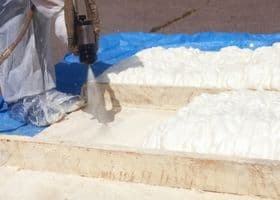 There are many insulating materials available that can keep your home comfortable. But none of them are quite like spray foam. This unique product has lots of merits and is probably the reason it's becoming popular in many households and businesses. So, what is spray foam made of? How does it work? Read on and find out! What components make up the spray foam? The spray foam solution is a combination of isocyanate and polyol resins. These two chemicals form a polyurethane foam in a reaction. Polyurethane has low conductivity of heat due to its complex chemical structure. It's the reason why the material works best as an insulator. The foam mixture insulates buildings by sealing cavities and spaces along the walls. These fillings trap air which cushions against the loss of heat through conduction. The spray is often added in attics, crawl spaces, new constructions, and rim joints. It easily takes the shape of the cavity without sagging or settling even after curing. Polyurethane has been in use for insulation since the 70s. It, thus, has a history of quality, reliability, and success. Spray foam comes in two forms; open-cell foam and closed-cell foam. Each has unique properties and benefits that make it useful in different applications. Open-cell foam Open-cell spray foam is a lighter and more pliable form of polyurethane. It has more comprehensive expansion limits than closed-cell spray foam. Hence, an excellent sound barrier and is more flexible in structure. Open-cell spray foam is more affordable compared to closed-cell spray foam. In addition, it offers insulation and soundproofing benefits. These properties make it ideal in areas with high noise pollution. Think of industrial zones and buildings neighbouring the highways. Closed-cell spray foam Closed-cell spray foam is heavier, denser, and thicker than open-cell polyurethane. Its high density offers a better R-value compared to the open-cell foam alternative. The R-value is the resistance of insulation material to heat flow. Due to its low expansion capabilities, closed-cell foam is also an excellent option for smaller structures such as sheds and cargo vans. (1) Why should you use the spray foam?
Don't let your energy bills give you sleepless nights. Protect your home against the changing seasons by insulating it with spray foam. At All Florida Insulation, we offer our clients top-quality spray foam insulation services. We have a team of experts who will help you choose the best option for your needs. We also have the right equipment and experience to do the job quickly and efficiently. If you're a resident or business in Orlando, Ocoee, Gotha, Apopka, Lake Mary, or Windermere, make sure to contact us for a free quote today. Click to learn more about us. 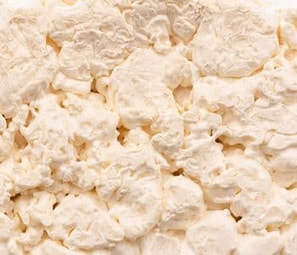 Have you ever wondered what those big white trucks are spraying into people's homes? It's insulation! More specifically, it's spray foam insulation. But what is it, and what is it made of? This article will take a closer look at spray foam insulation and find out what it's made of. What is spray foam insulation? Spray foam is a type of insulation sprayed onto walls, ceilings, and floors to insulate and seal a home or building. It prevents air and heat from escaping, making it much more energy-efficient than other types of insulation. Unlike other insulation materials, spray foam expands to fill gaps or cracks, making it an excellent choice for difficult-to-insulate areas. It also doesn't sag, compress or settle over time like fiberglass or cellulose insulation. That's not all. Spray foam insulation also:
Spray foam comes in two types: closed-cell and open-cell. While both create an effective insulation barrier, they have some key differences. Closed-cell spray foam has a higher R-value (resistance to heat flow), meaning it's much more effective at insulating your home in Orlando. It's also denser, making it more durable and resistant to pests and water damage. On the other hand, open-cell spray foam has a lower R-value, but it's much cheaper than closed-cell foam. It's also more breathable, making it a good choice for areas that need ventilation, like attics. So, what is spray foam insulation made of? The main ingredient in spray foam insulation is polyurethane. This polymer is made up of two chemicals, isocyanate and polyol resin. These two ingredients are mixed and sprayed through a nozzle, where they react and expand to create the foam. (1) Additives are added to the mix to control the foam's density, expansion rate, and other properties. Common additives include:
Now that you know what spray foam insulation is made of, you can see why it's such an effective way to insulate your home in Orlando. Not only does it expand to fill any gaps or cracks, but it also has a high R-value, making it excellent at preventing heat loss. So spray foam is a great option if you're looking for an insulation material that will do a great job at keeping your home warm. All Florida Insulation services Orlando, Windermere, Gotha, and Winter Garden, and wContacte appreciate the support of our communities. Call us at (407) 410-FOAM (3626) to request a free quote. Click to see all our services. |
Chris Curry
Chris has been an insulation professional for more than two decades, and has experience with all types of residential and commercial insulation products. His passion is green energy and effective insulation applications. Archives
June 2024
Categories
All
|
CALL: (407) 410-FOAM (3626)
SERVING ALL OF CENTRAL FLORIDA
SERVING ALL OF CENTRAL FLORIDA

 RSS Feed
RSS Feed
